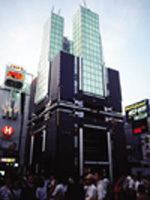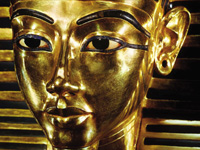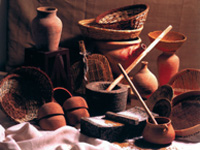Kirin Plaza Osaka Applies Brains to Beer
Back to Contents of Issue: December 2003
|
|
|
|
by Dominic Al-Badri |
|
|
Since its construction, the Kirin Plaza Osaka has built a formidable reputation in the international contemporary art circuit but caused few ripples beyond, despite its prime location -- and the fact that it is far more than just an art complex. Recent exhibitions have included the work of the London-based female Japanese artist known simply as Tabaimo, whose video installations contain such charming delights as so-labelled "high-grade men's brains," a jar of innards shown frying in a saucepan, and Osaka-based painter Yayoi Deki, whose paintings consist of thousands of tiny faces. If you think that's bizarre, especially for normally conservative Japanese art venues, then the recent exhibition of Yoshihiko Sato's 12-necked guitars and five-seater mopeds shows just how refreshingly capacious the Kirin Plaza Osaka's definition of "art" can be.
While the top three floors of the building are given over to an exhibition hall and gallery, the first three floors pay tribute to what Kirin does best: brewing beer. A range of microbrews are crafted on the premises, and anyone who thinks Kirin only makes bland mass-produced lagers is in for a shock.
To keep the masses apprised of the latest brew news, there is a beer lecture hall, where seminars and tasting events are held regularly.
Sakuji Yoshimura, an Egyptologist at Waseda University in Tokyo, transcribed the recipe for the two beers Kirin has thus far recreated from hieroglyphics found inside the tomb of Kenamen in Saqqara, southwest of the modern-day Egyptian capital, Cairo. The first batch of beer was made last year and followed a recipe dating back to Egypt's Old Kingdom (2,650 BC to 2,180 BC).
Following exactly the same recipe used by the Pharaohs was one thing, but in order to ensure that the taste and process was as authentic and as accurate as possible, Kirin obtained the earthenware jugs, vessels and pots that were used 4,000 years ago. In a complex, three-week long labor-intensive process, replica beer was made using barley and wheat. (Unlike modern beer, no hops were involved.) Following the successful production of the Old Kingdom Beer, Kirin decided earlier this year to try making beer according to a recipe from the time of Egypt's New Kingdom (1570 BC to 1070 BC).
"This beer won't be going on sale," Kurokawa announced. "The amount of work involved in producing just this small amount would make it impossible for us to produce it on a large scale."
The first beer to be circulated was the 2002 Old Kingdom brew. Assorted TV film crews zoomed in as we gingerly sipped at the small plastic cups, unsure of what we would taste. With an alcohol content of some 10 percent, the Old Kingdom beer was closer to a wine than a modern-day beer, though it was not that dissimilar to some Belgian beers.
Everybody really wanted to be among the first in the world to sample the New Kingdom beer. The Ancient Egyptians lost the original recipe during the thousand years between the Old and New Kingdoms. The two brews are literally worlds apart.
The sourdough, which also doubled as a component in the brewing process, was even more alien to the modern palate than the New Kingdom beer. We might as well have been trying to swallow a mouthful of dry yeast. "This is the most revolting thing we've had so far," complained the reporter from Brewery Times.
"We had to keep this very quiet beforehand," said Yoshiaki Sakou, an employee at Kirin Plaza Osaka. "There are 400 Kirin employees in Kansai alone, and if they had known about this event they'd all have wanted to come."
Understandably, Kirin is not making the New Kingdom beer available either, though in this instance they're doing everyone a favor.
Good taste
In 2004 Kirin aims to recreate a European brew originating in the Middle Ages and known as "Gruit Beer" -- another beer made without hops. And in 2005, the company will replicate the first beer ever to be brewed in Japan, dating back to the Edo Period.
However interesting the experience was, we found ourselves wondering about the point of the whole exercise. It must have cost millions of yen, and it appeared to be a prime example of Japanese corporate showboating: doing something just for the sake of doing it.
The event was tastefully stimulating for those involved (if sometimes jarringly unpleasant), and certainly provocative intellectually. But there are no practical applications to which this historical beer revival can be applied.
Kurokawa was amply prepared for our second thoughts -- and answered them with true otaku philosophizing: "We wanted to recreate this beer as exactly and as precisely as we could to try to better understand the history of beer -- and what it is that people have found so appealing about beer over the years. Kirin is not just about making profits from product: We want people to appreciate and understand beer culture better, and spread the word." @
|
|
Note: The function "email this page" is currently not supported for this page.


 ONE OF OSAKA'S MOST interesting, architecturally innovative and yet strangely unheralded institutions is named after a brand of beer. The Kirin Plaza Osaka, located in the heart of the city just north of the infamous Ebisubashi bridge (from which Hanshin Tigers fans plunge into the murky Dotombori canal), was designed by prize-winning architect Shin Takamatsu and erected in 1987.
ONE OF OSAKA'S MOST interesting, architecturally innovative and yet strangely unheralded institutions is named after a brand of beer. The Kirin Plaza Osaka, located in the heart of the city just north of the infamous Ebisubashi bridge (from which Hanshin Tigers fans plunge into the murky Dotombori canal), was designed by prize-winning architect Shin Takamatsu and erected in 1987.
 Sweet and sour
Sweet and sour
 Mouthful of yeast
Mouthful of yeast




